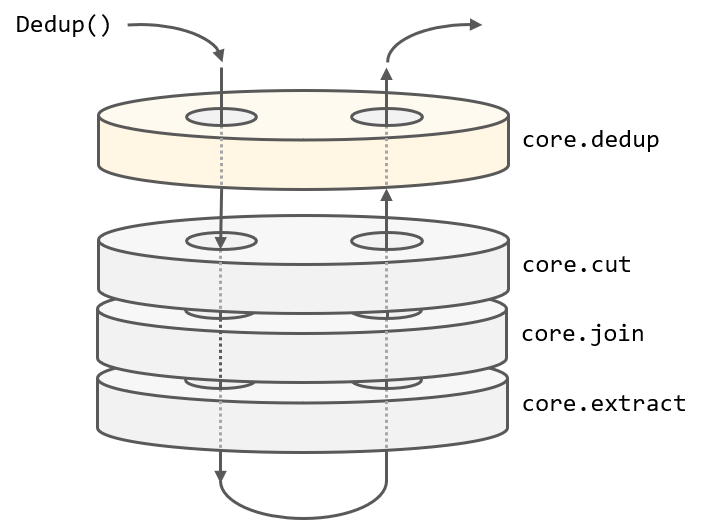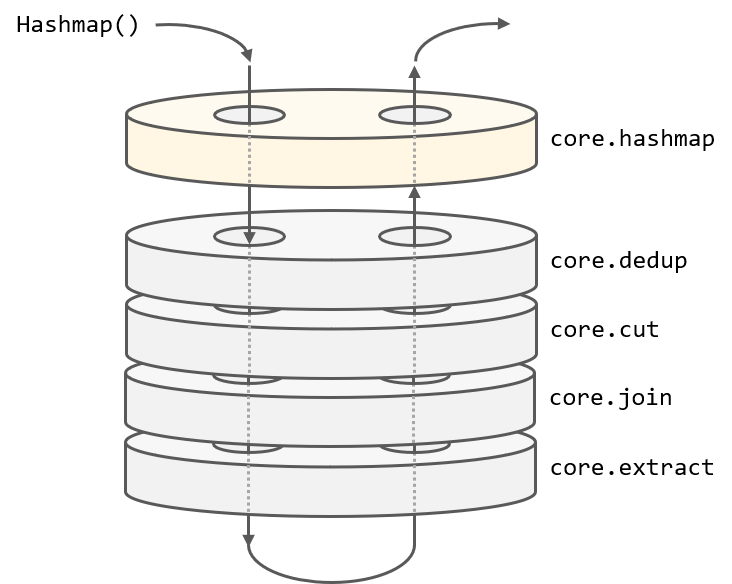How it works
With topojson it is possible to reduce the file size of your geographical data. This is often useful if you are aiming for browser-based visualizations (eg. visualizations in JupyterLab or on the Web).
As explained before we can do so through:
- Eliminating redundancy through computation of a topology
- Fixed-precision integer encoding of coordinates and
- Simplification and quantization of arcs
Topology computation
While the 2nd and 3rd bullets from above list have a significant impact on the filesize reduction, we will describe here the 1st bullet -the computation of the Topology- since it is basically the core of this library.
The computation of the Topology involves secure bookkeeping on multiple levels in order to successfully pass all steps. The following levels in derivation can be distinguished, which are explained below:
Toy example
The following example data is used to clarify the steps:
Example 🔧
from IPython.display import display, SVG
from shapely import geometry
import topojson as tp
data = geometry.MultiLineString([
[(0, 0), (10, 0), (5, 5), (15, 5)],
[(15, 0), (15, 5), (5, 5), (0, 5)]
])
s = data._repr_svg_()
s = s.replace('stroke="#66cc99"', 'stroke="#F37929"', 1)
s = s.replace('stroke-width="0.324"', 'stroke-width="0.7"', 1)
display(SVG(s))
The orange line starts bottom-left and goes with a zig-zag to top-right. The green line starts bottom-right and goes up and then leftwards. Resulting in a shared segment for the two linestrings in opposite directions.
Extract
The first step is Extract.

This class instance is determines the geometrical type of input data (eg. dict, geojson.FeatureCollection, geopandas.GeoDataFrame), and based on the type it extracts all geometric entities as shapely.geometry.LineString’s or shapely.geometry.Point’s and stores them in a top-level object with references in each geometric entity.
Target objectives:
- Detection of geometrical type of the input data
- Extraction of linestrings and points from all geometric entities
Example 🔧
We use the data as is prepared in the toy example section.
from topojson.core.extract import Extract
Extract(data)
Extract(
{'bookkeeping_coords': [],
'bookkeeping_geoms': [[0], [1]],
'coordinates': [],
'linestrings': [<shapely.geometry.linestring.LineString object at 0x0000020C4B5B2E08>,
<shapely.geometry.linestring.LineString object at 0x0000020C4B5B2AC8>],
'objects': {0: {'arcs': [0, 1], 'type': 'MultiLineString'}},
'type': 'Topology'}
)
The Extract class creates an object with a few different keys. From top to bottom are these
bookkeeping_coordswhich stores the references to all point-coordinates. In this input are no existing point-coordinates.bookkeeping_geomswhich stores the references to all geometries, such as LineStrings and Polygons.coordinatesthe actual point-coordinateslinestringsall actual LineStrings extracted from both Polygons, LineStrings and LinearRings.objectsa dictionary with all input objects. Here is presented a single MultiLineString with two referenced arcs.
The two referenced arcs [0, 1] refer to 0-index and 1-index entry in the bookkeeping_geoms. In this case [0] and [1] respectively.
Extract(data).to_svg(separate=True)
0 LINESTRING (0 0, 10 0, 5 5, 15 5)1 LINESTRING (15 0, 15 5, 5 5, 0 5)

Join
The second step is Join. The Join class pass the data first down towards the Extract class, before starting the Join phase.

- Quantization of input linestrings if necessary
- Identifies junctions of shared paths
Example 🔧
We use the data as is prepared in the toy example section.
from topojson.core.join import Join
Join(data)
Join(
{'bbox': (0.0, 0.0, 15.0, 5.0),
'bookkeeping_coords': [],
'bookkeeping_geoms': [[0], [1]],
'coordinates': [],
'junctions': [<shapely.geometry.point.Point object at 0x0000020C8D94BC88>,
<shapely.geometry.point.Point object at 0x0000020C8D975348>],
'linestrings': [<shapely.geometry.linestring.LineString object at 0x0000020C8D94BE48>,
<shapely.geometry.linestring.LineString object at 0x0000020C8D956F08>],
'objects': {0: {'arcs': [0, 1], 'type': 'MultiLineString'}},
'type': 'Topology'}
)
The Join class creates an object based on the Extract object. From top to bottom are these
bbox: this is the maximum extent from all LineStrings and Coordinates stored within theExtractclass.bookkeeping_coordssee Extract.bookkeeping_geomssee Extract.coordinatesthe actual point-coordinatesjunctionsthe detected end-coordinates of a segment that is shared with at least two geometries.linestringssee Extract.objectssee Extract.
The junctions is a new key that stores all junctions as a list of shapely Points.
Join(data).to_svg(separate=True, include_junctions=True)
0 LINESTRING (0 0, 10 0, 5 5, 15 5)1 LINESTRING (15 0, 15 5, 5 5, 0 5)

Cut
The third step is Cut. The Cut class passes the data first down towards the Extract and subsequently Join class, before starting the Cut phase.

- Split linestrings given the junctions of shared paths
- Identifies indexes of linestrings that are duplicates
Example 🔧
We use the data as is prepared in the toy example section.
from topojson.core.cut import Cut
Cut(data)
Cut(
{'bbox': (0.0, 0.0, 15.0, 5.0),
'bookkeeping_coords': [],
'bookkeeping_duplicates': array([[3, 1]], dtype=int64),
'bookkeeping_geoms': [[0], [1]],
'bookkeeping_linestrings': array([[ 0., 1., nan],
[ 2., 3., 4.]]),
'coordinates': [],
'junctions': [<shapely.geometry.point.Point object at 0x0000020C8D937C48>,
<shapely.geometry.point.Point object at 0x0000020C8D937688>],
'linestrings': [array([[ 0., 0.],
[10., 0.],
[ 5., 5.]]),
array([[ 5., 5.],
[15., 5.]]),
array([[15., 0.],
[15., 5.]]),
array([[15., 5.],
[ 5., 5.]]),
array([[5., 5.],
[0., 5.]])],
'objects': {0: {'arcs': [0, 1], 'type': 'MultiLineString'}},
'type': 'Topology'}
)
The Cut class creates an object based on the Join object. From top to bottom are these
bbox: see Join. Not changed.bookkeeping_coordssee Extract. Not changed.bookkeeping_duplicatesnested arrays where each array are the referenced linestrings that are duplicates (albeit reversed) from each other.bookkeeping_geomssee Extract. Not changed.bookkeeping_linestringssince the linestrings are split using the junction-points, this key maintain the bookkeeping which LineStrings appeared in which geometry.coordinatessee Extract. Not changed.junctionssee Extract. Not changed.linestringsin the process of splitting LineStrings on detected junctions, the object type is changed from shapely LineString to NumPy arrays in order to make use of matrix-wise splitting.objectssee Extract. Not changed.
The bookkeeping_linestrings is a new key.
Cut(data).to_svg(separate=True, include_junctions=True)
0 LINESTRING (0 0, 10 0, 5 5)1 LINESTRING (5 5, 15 5)
2 LINESTRING (15 0, 15 5)
3 LINESTRING (15 5, 5 5)
4 LINESTRING (5 5, 0 5)

Dedup
The fourth step is Dedup. The Dedup class passes the data first down towards the Extract and subsequently Join and Cut class, before starting the Dedup phase.

- Deduplication of linestrings that contain duplicates
- Merge contiguous arcs
Example 🔧
We use the data as is prepared in the toy example section.
from topojson.core.dedup import Dedup
Dedup(data)
Dedup(
{'bbox': (0.0, 0.0, 15.0, 5.0),
'bookkeeping_arcs': [[0, 2], [1, 2, 3]],
'bookkeeping_coords': [],
'bookkeeping_duplicates': [],
'bookkeeping_geoms': [[0], [1]],
'bookkeeping_shared_arcs': [2],
'coordinates': [],
'junctions': [<shapely.geometry.point.Point object at 0x0000020C8D956848>,
<shapely.geometry.point.Point object at 0x0000020C8D956908>],
'linestrings': [array([[ 0., 0.],
[10., 0.],
[ 5., 5.]]),
array([[15., 0.],
[15., 5.]]),
array([[15., 5.],
[ 5., 5.]]),
array([[5., 5.],
[0., 5.]])],
'objects': {0: {'arcs': [0, 1], 'type': 'MultiLineString'}},
'type': 'Topology'}
)
The Dedup class creates an object based on the Cut object. From top to bottom are these
bbox: see Join. Not changed.bookkeeping_arcsthis is the resolved version ofbookkeeping_linestrings, where the linestring indexed by2is referred in both arcs.bookkeeping_coordssee Extract. Not changed.bookkeeping_duplicatesduplicates are resolved in the keybookkeeping_arcs.bookkeeping_geomssee Extract. Not changed.bookkeeping_shared_arcsobject that stores the linestrings that are sharedcoordinatessee Extract. Not changed.junctionssee Extract. Not changed.linestringsduring deduplication the linestring that are seen as duplicates are popped.objectssee Extract. Not changed.
The bookkeeping_arcs and bookkeeping_shared_arcs are new keys that stores all shared arcs and maintain bookkeeping.
Dedup(data).to_svg(separate=True)
0 LINESTRING (0 0, 10 0, 5 5)1 LINESTRING (15 0, 15 5)
2 LINESTRING (15 5, 5 5)
3 LINESTRING (5 5, 0 5)

Hashmap
The fifth step is Hashmap. The Hashmap class passes the data first down towards the Extract and subsequently Join, Cut and Dedup class, before starting the Hashmap phase.

- Resolves bookkeeping results to object arcs.
Example 🔧
We use the data as is prepared in the toy example section.
from topojson.core.hashmap import Hashmap
Hashmap(data)
Hashmap(
{'bbox': (0.0, 0.0, 15.0, 5.0),
'coordinates': [],
'linestrings': [array([[ 0., 0.],
[10., 0.],
[ 5., 5.]]),
array([[15., 0.],
[15., 5.]]),
array([[15., 5.],
[ 5., 5.]]),
array([[5., 5.],
[0., 5.]])],
'objects': {'data': {'geometries': [{'arcs': [[0, -3], [1, 2, 3]],
'type': 'MultiLineString'}],
'type': 'GeometryCollection'}},
'type': 'Topology'}
)
The Hashmap class creates an object based on the Dedup object. From top to bottom are these
bbox: see Join. Not changed.coordinatessee Extract. Not changed.linestringssee Dedup. Not changed.objectsin thearcsobject the geometries are resolved usingbookkeeping_geomwhich uses thebookkeeping_arcs. In this process the shared arcs are analyzed if they should be reversed or not in the referred geometry. Observer-3and2.
The bookkeeping_* keys are removed and the arcs for each geometry within objects is updated.
Topology
The sixth and last step is Topology. The Topology class passes the data first down towards the Extract and subsequently Join, Cut, Dedup and Hashmap class, before starting the Topology phase.

- Applies all custom settings and output functions.
Example 🔧
We use the data as is prepared in the toy example section.
from topojson.core.topology import Topology
Topology(data)
Topology(
{'arcs': [[[0, 0], [666666, 0], [-333333, 999999]],
[[999999, 0], [0, 999999]],
[[999999, 999999], [-666666, 0]],
[[333333, 999999], [-333333, 0]]],
'bbox': (0.0, 0.0, 15.0, 5.0),
'coordinates': [],
'objects': {'data': {'geometries': [{'arcs': [[0, -3], [1, 2, 3]],
'type': 'MultiLineString'}],
'type': 'GeometryCollection'}},
'transform': {'scale': [1.5000015000015e-05, 5.000005000005e-06],
'translate': [0.0, 0.0]},
'type': 'Topology'}
)
The Topology class creates an object based on the Hashmap object. From top to bottom are these
arcs: the inlinestringstored NumPy is quantized (normalized, delta-encoded) and converted into lists.bbox: see Join. Not changed.coordinatessee Extract. Not changed.objectssee Hashmap. Not changed.transformstores thescaleandtranslatekeys, which can be used for dequantization of the quantized arcs.
The arcs key is created storing the quantized linestrings, where shared arcs are referred from within each geometry.
Topology(data).to_svg()
The names are borrowed from the JavaScript variant of TopoJSON, to establish a certain synergy between the packages, even though the code differs significant (and sometimes even the TopoJSON output).